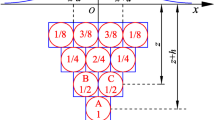Abstract
The ground freezing construction technique is one of the most effective and widely applied site construction methods in soft soil areas, like Shanghai. Some elevation-inclined refrigeration pipes are arranged for the artificial freezing excavation of the Pudong-side first-storey connection aisle, which is designed to connect two adjacent tunnel lanes of Shanghai East-Fuxing-Road tunnel project. No advanced research results could be found for computing the temperature field of tunnels and aisles frozen with inclined refrigeration pipes. Anyhow the computation of the relevant temperature field is of high importance for the safe and economical excavation of the above-mentioned aisle. In this paper, a method for computing the aisle temperature field using 3D FEM is given, and the computation accuracy is verified by contrasting the computed and site measured results. The back propagation neural networks are also applied to the temperature prediction using self-developed Neural Network-Expert System software, the predicted results are also very satisfactory. The mechanism during freezing and aisle excavation will be discussed on the basis of 3D FEM simulation. The authors believe that studying the parameter-sensitivity of temperature field is very important for the optimum selection of parameter values. So, in this paper, the parameter-sensitivity of temperature field is also discussed. In order to obtain the optimum frozen wall thickness, the relation between the frozen wall thickness and the initial freezing brine temperature is studied. At the end, an excavation pre-control plan is proposed by means of fuzzy logic theory for improving the excavation safety. The research result of the current paper is very helpful for projects that will be excavated by freezing construction technique.

















Similar content being viewed by others
References
Bolzon G, Schrefler BA (2005) Thermal effects in partially saturated soils: a constitutive model. Int J Numer Anal Methods Geomech 29(9):861–877
Boone SJ, Crawford AM (2000) Braced excavations: temperature, elastic modulus, and strut loads. J Geotech Geoenviron Eng 126(10):870–881
Chen XS (1988) Mechanical characteristics of artificially frozen clays under triaxial stress condition. Ground Freeing 88, vol. 1. A.A. Balkema, Rotterdam, pp 173–179
Chen YL (2005) Intelligent geotechnical engineering. Shaker Verlag, Aachen, pp 90–110
Chen YL, Azzam R, Zhang FB, Pan ZT (2004) The prediction of construction control plan of deep foundation pit excavation utilizing back-propagation neural network and fuzzy logical control. Mitt Ingenieurgeol Hydrogeol 88:81–98
Chen YL, Azzam R, Zhang FB (2006) The displacement computation and construction pre-control of a foundation pit in Shanghai utilizing FEM and intelligent methods. Geotech Geol Eng 24(6):1781–1801
EINAV I (2004) Thermomechanical relations between stress-space and strain-space models. Geotechnique 54(5):315–318
Harris JS (1995) Ground freezing in practice. Thomas Telford, London, pp 4–14
Master I, Pao WKS, Lewis RW (2000) Coupling temperature to a double-porosity model of deformable porous media. Int J Numer Methods Eng 49(3):421–438
Neaupane KM, Achet S (2004) Use of backpropagation neural networks for landslide monitoring: a case study in the Higher Himalaya. Eng Geol 3–4(74):213–226
Neaupane KM, Adhikari N (2006) Prediction of tunneling-induced ground movement with the multi-layered perception. Tunn Undergr Space Dev 21:151–159
Neaupane KM, Yamabe T (2001) A fully coupled thermo-hydro-mechanical (THM) non-linear model in a frozen medium. Comput Geotech 28(8):613–637
Neaupane KM, Yamabe T, Yoshinaka R (1999) Simulation of a fully coupled thermo- hydro-mechanical system in freezing & thawing rock. Int J Rock Mech Min Sci 36(5):563–580
Sopko JA (1989) Ground freezing to control ground water and support deep storm sewer structural excavations. Proceedings of rapid excavation and tunneling conference, Los Angeles
Sopko JA (1991) Ground freezing to provide support for tunneling using vertical refrigeration pipes. Proceedings of rapid excavation and tunneling conference, Seattle, Washington
Xu SL (2004) The mathematical model of temperature field for the vertical shaft under freezing construction by employing two rings of refrigeration pipes. J Anhui Inst Archit Ind 12(3):10–12 (in Chinese)
Yang GS, Zhang J (2003) Numerical analysis on non-uniformly distributed temperature field for a frozen-wall supported deep foundation pit during excavation by means of FEM method. Chin J Rock Mech Rock Eng 22(2):316–320 (in Chinese)
Acknowledgements
The financial support from the Heinrich Hertz-Stiftung, National Natural Science Foundation of China (59809005) and USST Research Foundation for this study is gratefully acknowledged.
Author information
Authors and Affiliations
Corresponding author
Rights and permissions
About this article
Cite this article
Chen, YL., Azzam, R., Fernandez-Steeger, T.M. et al. Studies on Construction Pre-control of a Connection Aisle Between Two Neighbouring Tunnels in Shanghai by Means of 3D FEM, Neural Networks and Fuzzy Logic. Geotech Geol Eng 27, 155–167 (2009). https://doi.org/10.1007/s10706-008-9220-5
Received:
Accepted:
Published:
Issue Date:
DOI: https://doi.org/10.1007/s10706-008-9220-5




